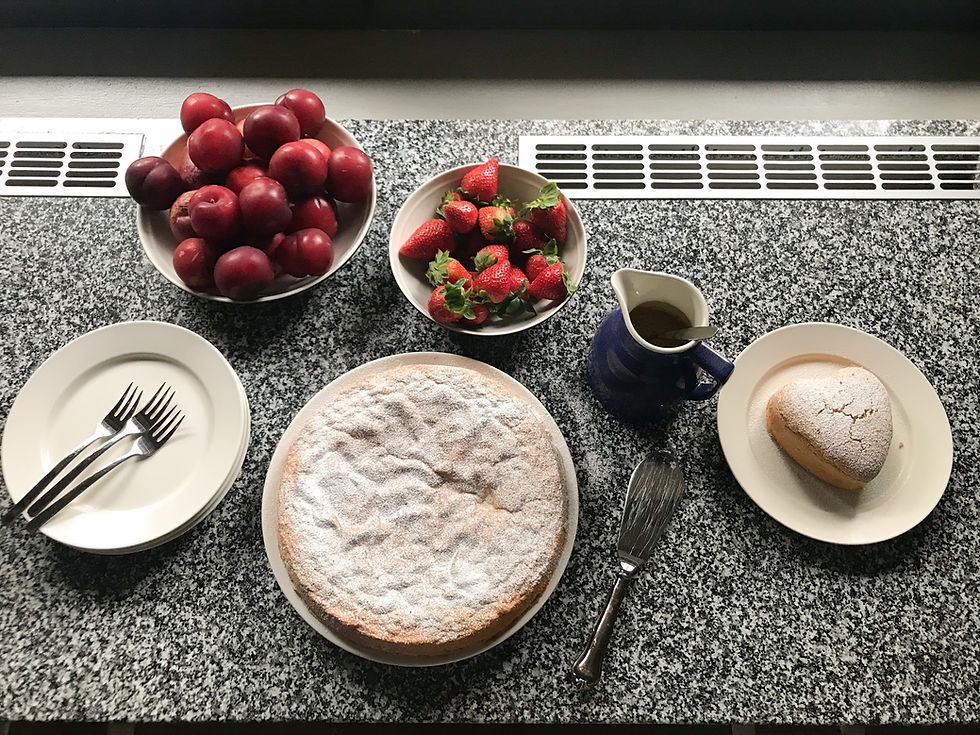Pearls, Curls & French Cuisine – Chapter 7: Gâteau Fourré à la Crème d'Orange
- Siiri

- Jun 17
- 3 min read
Dearest reader,
After baking my first French cake I was on a sugar high so lofty that I immediately had to try a second recipe out of the five cakes Julia Child has included in her book. Since it was the beginnig of June, and that sweet promise of long awaited summer hanged on air as thick as pollen on garden furniture, a gâteau à l'orange sounded like an irresistably tasty addition to my summer cake repertoire. However, this wasn't just your everyday orange cake, but one stuffed with orange butter hence the name gâteau fourré à la crème d'orange.
So I put on my pearls,
tied back my curls and
opened page 564 on
Mastering the Art of French Cooking
The Process of Gâteau à l'Orange
Similar to biscuit au beurre, gâteau à l'orange doesn't require baking powder to rise because of the whipped egg whites added at the very end act as raising agent. The cake baking process overall resembles each other – starting by whipping together egg yolks and sugar – and varies only in the addition of orange peel and juice as well as in the order which flour and egg whites are added. Namely, in biscuit au beurre flour and egg whites are added together whereas in gâteau à l'orange flour goes first and then you gradually add in the egg whites.
All you need for gâteau à l'orange are:
sugar, egg yolks and whites, orange peel and juice, flour and salt.
Finally, the finished cake texture is the same light and spongy consistency just with a different flavour.

The Process of Crème d'Orange
If biscuit au beurre required a rhubarb sauce, then gâteau à l'orange was the perfect opportunity to try out an orange butter filling according to our own Julia Child. The process seemed simple enough: all ingredients are placed in a pot in medium heat and stirred until it forms a honey like substance.
All you need for crème d'orange are:
butter, sugar, eggs, egg whites, orange peel and juice, and orange liqueur.
After the pot had been taken off the heat, you whisk the crème for a few minutes until it has cooled off. However, here is where it got confusing because Julia doesn't describe how the finished crème should look like. Is it thick? Runny? Or airy? My only clue was the honey like substance. Naturally, I ended up whisking the crème for an hour before deciding that it's propably one of those more liquid fillings that is meant to absorb itself into the cake sponge. However, if any of you have experience with this recipe or are French I would appreciate if you could let me know how it's meant to be. Merci!
Lastly, I cut and filled the cake with as much filling as I could but, of course, it did run over a bit.

The Result
Despite my dramatic struggles with crème d'orange the actual cake was very sweet and delicous, and indeed a succeess in terms of flavour. What's more, crème d'orange would also be perfect inside a strawberry cake with whipped cream. However, I do have to confess that making this cake was mentally unpleasant and while it was good, I cannot help but feel it was a little bit of a fail.
All I can say is: may our next cake filling be a better one.
Until next time!
Yours Truly,
Siiri
P.S. if you liked this post tap the heart below, so I know to make more like this!
How has your crème d'orange filling turned out?
When was the last time you failed at baking?
Sources:
Child, Julia; Bertholle, Louisette & Beck, Simone. (1961). Ranskalaisen keittiön salaisuudet. WSOY 1983








Comments